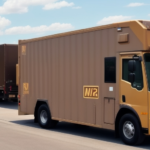Understanding the Entire Shipping Process
As a business owner, comprehending the entire shipping process is crucial for operational success. From selecting the appropriate shipping method to tracking shipments and ensuring customer satisfaction, numerous factors must be considered. This comprehensive guide delves into the shipping process, offering detailed insights to optimize efficiency and effectiveness for your business.
Why Understanding the Shipping Process is Important
Grasping the intricacies of the shipping process offers several advantages:
- Optimal Shipping Method Selection: Choose methods that best suit your products and business needs.
- Timely and Safe Deliveries: Ensure shipments arrive on time and in good condition, fostering customer loyalty.
- Cost Efficiency: Streamline operations to save time and reduce expenses, reallocating resources to other business areas.
Additionally, a deep understanding allows businesses to anticipate and mitigate potential transit issues, such as protecting fragile items or managing perishable goods effectively. Navigating customs and regulatory requirements becomes more manageable, preventing delays and avoiding penalties.
Shipping Methods and How to Choose the Right One
Types of Shipping Methods Available
Various shipping methods cater to different business needs:
Ground Shipping
Ground shipping is the most cost-effective option for domestic shipments, suitable for non-urgent deliveries. It is ideal for businesses looking to minimize shipping costs while maintaining reliable delivery times.
Air Shipping
Air shipping offers the quickest delivery times for both domestic and international shipments. It's perfect for urgent deliveries or high-value items requiring expedited transit.
Sea Shipping
Sea shipping is a slower but more economical choice for international shipments, especially for large volumes or bulky goods. It's suitable for businesses with flexible delivery schedules and cost-sensitive operations.
Rail Shipping
Rail shipping is gaining popularity as a cost-effective and environmentally friendly option for domestic shipments. It produces fewer carbon emissions compared to other methods but may have limited availability in certain regions.
How to Choose the Right Shipping Method for Your Business
When selecting a shipping method, consider the following factors:
- Product Size and Weight: Heavier and bulkier items may be more cost-effective to ship via ground or sea.
- Delivery Distance: Domestic versus international shipping can determine the most suitable method.
- Urgency: Time-sensitive shipments may require air shipping to meet delivery deadlines.
- Security Needs: High-value items might necessitate more secure shipping options.
- Environmental Impact: Opt for eco-friendly shipping methods to appeal to environmentally conscious consumers.
Balancing these factors ensures that you select a shipping method that aligns with your business objectives and customer expectations.
Challenges and Solutions in the Shipping Process
Common Challenges
Shipping processes can encounter several challenges, including:
- Delays: Adverse weather conditions, customs holdups, and logistical issues can cause unexpected delays.
- Damage During Transit: Inadequate packaging can lead to product damage, resulting in returns and customer dissatisfaction.
- Miscommunication: Incorrect delivery addresses or shipment information can disrupt the delivery schedule.
Solutions to Overcome Challenges
To mitigate these challenges:
- Utilize Real-Time Tracking: Implement GPS tracking to monitor shipments and address issues promptly.
- Enhance Packaging: Use appropriate materials and methods to protect products during transit.
- Improve Communication: Maintain clear and consistent communication with carriers to ensure accuracy.
- Leverage Technology: Adopt shipping software to automate processes and reduce human error.
Incorporating these solutions can lead to a more resilient and reliable shipping process.
International Shipping Essentials
Understanding Customs and Duties
Customs and duties are tariffs imposed on imported goods, varying by country and product type. It's essential to:
- Research Tariffs: Understand the specific tariffs and regulations for each destination country. Resources like the U.S. Customs and Border Protection provide detailed information.
- Prepare Accurate Documentation: Ensure all necessary paperwork accompanies your shipment to prevent delays.
- Classify Products Correctly: Proper classification can affect duty rates and compliance requirements.
Best Practices for International Shipping
To ensure successful international shipments:
- Use Appropriate Packaging: Protect products against varying environmental conditions during transit.
- Choose Reliable Carriers: Select carriers with proven international delivery records.
- Stay Informed on Regulations: Keep up-to-date with changing international shipping laws and standards.
The Role of Technology in Modern Shipping
Technological advancements have revolutionized the shipping industry, enhancing efficiency and reliability. Key technologies include:
- Real-Time Tracking: Allows businesses and customers to monitor shipments in real-time, improving transparency and trust.
- Automation: Streamlines order processing, inventory management, and shipment tracking, reducing manual errors.
- Drones and Autonomous Vehicles: Innovations like drone deliveries and self-driving trucks promise faster and more efficient shipping, though regulatory challenges remain.
- Artificial Intelligence (AI): AI optimizes routing, predicts delays, and enhances decision-making processes.
Implementing these technologies can significantly enhance your shipping operations, making them more efficient and scalable.
Cost Management and Efficiency in Shipping
Strategies for Reducing Shipping Costs
Shipping expenses can heavily impact your bottom line. To manage and reduce costs:
- Negotiate with Carriers: Establish partnerships and negotiate rates with shipping companies to secure better deals.
- Optimize Packaging: Use appropriately sized packaging to minimize dimensional weight charges and reduce material costs.
- Consolidate Shipments: Combine multiple orders into a single shipment to take advantage of bulk shipping rates.
- Use Freight Brokers: Freight brokers can find competitive rates and efficient shipping routes on your behalf.
- Implement Just-In-Time (JIT) Inventory: Reduce inventory levels to decrease the frequency and volume of shipments.
Efficient Order Fulfillment and Inventory Management
Effective order fulfillment and inventory management are pivotal for operational efficiency:
- Adopt Barcode Systems: Streamline inventory tracking and order processing.
- Utilize Inventory Management Software: Gain insights into inventory levels, track trends, and make informed restocking decisions.
- Automate Processes: Reduce manual intervention to increase accuracy and speed in order fulfillment.
Packaging and Customer Satisfaction
The Importance of Packaging
Proper packaging ensures that products reach customers in pristine condition:
- Use Appropriate Materials: Select packaging materials that provide adequate protection based on product fragility.
- Ensure Secure Sealing: Prevent tampering and damage by sealing packages securely.
- Optimize Package Size: Use the smallest possible packaging to reduce shipping costs and environmental impact.
Enhancing Customer Satisfaction
A seamless shipping experience fosters customer loyalty:
- Provide Tracking Information: Allow customers to monitor their shipments, increasing transparency and trust.
- Offer Multiple Shipping Options: Give customers flexibility in choosing delivery speeds based on their needs.
- Ensure Clear Communication: Keep customers informed about their order status and address any issues promptly.
- Invest in Branded Packaging: Enhance brand recognition and provide a memorable unboxing experience.
The Future of Shipping: Trends and Predictions
The shipping industry is continually evolving with emerging trends shaping its future:
- Increased Automation: Automation in warehouses and logistics will enhance speed and reduce costs.
- Eco-Friendly Practices: Sustainable shipping methods, such as electric vehicles and green packaging, will become more prevalent.
- Advanced Analytics: Data-driven approaches will optimize supply chains and predict trends.
- Blockchain Technology: Enhances transparency and security in supply chain transactions.
Staying abreast of these trends allows businesses to adapt and maintain a competitive edge in the shipping landscape.
Common Mistakes to Avoid in the Shipping Process
To ensure a smooth shipping process, avoid the following common mistakes:
- Poor Packaging: Inadequate protection can lead to damaged goods and increased returns.
- Miscommunication with Customers: Failing to provide accurate and timely information can erode trust.
- Ignoring Customs Requirements: Overlooking international shipping regulations can result in delays and fines.
- Underestimating Shipping Costs: Not accurately calculating shipping expenses can affect profitability.
- Lack of Tracking: Without tracking, both businesses and customers remain uninformed about shipment status.
By recognizing and addressing these pitfalls, businesses can enhance their shipping operations, reduce costs, and improve customer satisfaction.
Conclusion
Mastering the shipping process is essential for any business aiming to deliver products efficiently and maintain customer satisfaction. By understanding various shipping methods, overcoming challenges, leveraging technology, managing costs, and ensuring effective packaging, businesses can optimize their shipping operations. Staying informed about future trends and avoiding common mistakes further solidifies a company's position in the competitive market. Implement these strategies to ensure a smooth and successful shipping process, ultimately driving business growth and customer loyalty.




















